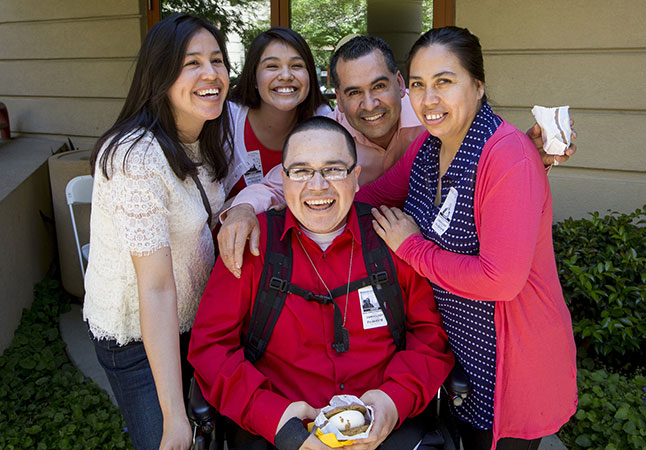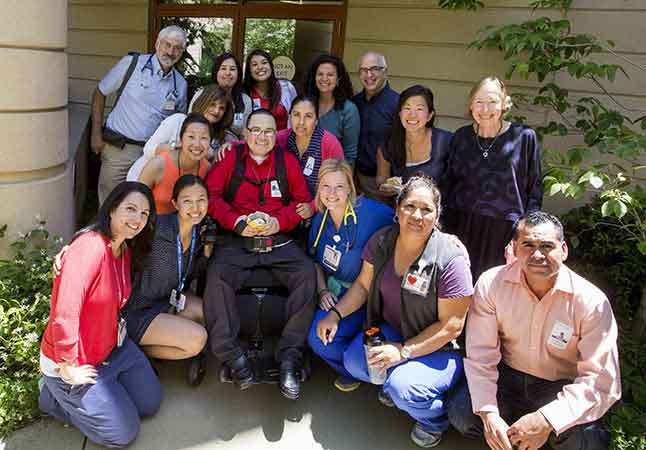Call today
Contact us to learn more or schedule an appointment.

The Arredondo Family: (left to right) Edgar’s sisters, Viviana and Daniela, father Jose and mother Imelda. Photo by Norbert von der Groeben
By Melissa Schenkman, MPH, MSJ
When people meet Edgar Arredondo, 21, of Newark, California, they are immediately drawn to his easygoing nature, his positive outlook on life and his unyielding smile. An aspiring graphic designer who has battled Becker Muscular Dystrophy since early elementary school, Edgar prefers pursuits where he can take things at his own pace, tackling them the same way he has taken on the rest of life’s challenges—all in stride.
It’s an approach that continues to captivate his family, friends and Heart Center health care team at Lucile Packard Children’s Hospital Stanford as he marks an extraordinary five years of living each day and each moment to its fullest with a ventricular assist device (VAD) attached to his heart.
“What jumps out at me about Edgar is that he is able to maintain enthusiasm, positivity and grace, all at once, in the face of a series of medical challenges,” said David Rosenthal, MD, director of the Ventricular Assist Device program.
Edgar‘s personal milestone is also a program record: He has been living on a VAD longer than any other pediatric patient in the Packard program’s history, and possibly in the country. To mark this milestone, Edgar and his family gathered recently in the hospital’s courtyard along with dozens of people from his care team, past and present, including members who were on their day off and those who have retired but who cared so much that they returned for the momentous occasion.
“Edgar, you have been an inspiration to all who have cared for you,” remarked Daniel Bernstein, MD, a pediatric cardiologist who has been closely involved in Edgar’s care over the years.
Edgar wore an ear-to-ear grin as he read aloud from a letter to his supporters, expressing his heartfelt gratitude to all who have helped him along his journey.

Edgar’s family and members of his care team at the recent 5-year-anniversary celebration: Top (left to right) Dan Bernstein, MD; Viviana Arredondo; Daniela Arredondo; Beth Kaufman, MD; David Rosenthal, MD. Middle (left to right) Esther Liu, NP; Claudia Miller, RN; Edgar Arredondo; Imelda Arredondo; Joanne Lee; Mary Burge. Lower (left to right) Sandra Rizzuto, OTD; Aileen Lin, NP; Jenna Murray, NP; Mary Collazo; Jose Arredondo. Photo by Norbert von der Groeben
At around age 6, a completely mobile Edgar noticed that he felt tired when walking long distances and fell more often than his classmates.
“It was hard to keep up with the other kids,” Edgar said. “When I used to go up the stairs or curbs, it was really hard. Those muscles weren’t as strong, I guess, so I couldn’t do those things.”
Edgar’s difficulty with movement was not just on his own radar. His mom and his teachers noticed, too.
At 9 years old, Edgar had a muscle biopsy. He was diagnosed with Becker Muscular Dystrophy (BMD), a genetic disease that causes muscle breakdown and weakness. It typically affects muscles in the thighs, hips, shoulders and pelvic area.
Edgar got around mostly by walking until he entered junior high, when he opted to use a wheelchair to navigate the larger campus. Other than that, the BMD did not faze him. School was going well and he had a loyal group of friends. “They would include me in everything, even if I couldn’t do anything,” Edgar said.
When he was a high school freshman, Edgar’s BMD began to show its unpredictable side. He felt very weak, had little appetite and often couldn’t keep his food down.
After a series of tests, it was determined that BMD was now affecting a very important muscle: his heart.
“With muscular dystrophy, you get a dilated cardiomyopathy, a weakness of the heart muscle that is in direct parallel to the skeletal muscle,” said Rosenthal.
Edgar was referred by Children’s Hospital Oakland to Lucile Packard Children’s Hospital Stanford, the only pediatric heart transplant center in northern California.
It’s a referral his family is very grateful for.
“Becoming a patient at Stanford was a new opportunity for Edgar to have life,” said Imelda Arredondo, Edgar’s mother. “The [doctors and nurses] love their work. They worry not just about the patient, but the family, too. No matter your background they treat you good.”
Mending poorly working hearts is nothing new for Packard Children’s. For years, the program has been using medications and VADs to keep children’s hearts functioning while they await a transplant.
Historically, life with a VAD has meant staying inside the hospital. Rosenthal and his team pioneered the use of durable VADs in kids, building the foundation for a treatment program that includes living at home and going to a mainstream school. The result for many patients is a higher quality of life.
“In 2010, we started using a VAD called the HeartMate II, which is totally implanted in the body and [has] wires on the outside [that are] easier to care for,” Aileen Lin, NP said. “Most places weren’t trying this in kids yet. At the time, it was a huge push in the field.”
In addition to providing medical care, a significant part of the VAD program is dedicated to educating patients and their families about the device, setting patients on a path to outpatient life.
“We train parents and siblings how to be ‘VAD Active’,” Lin said. “We teach them how to change the batteries and when to call Lucile Packard. We also inform the [emergency medical service providers] in the community where the patient lives to make them aware.”
When they were in high school together, Edgar’s sister Viviana would help him change his batteries every day at lunchtime.
“We learned to make the VAD a part of our lives. Sometimes when our mom is not home at night, I help Edgar get in bed and connect him to his home monitoring system,” Viviana said.
The program also addresses patients’ concerns about issues such as body image, being reliant on a machine and getting treated differently. This support makes patients and their families feel confident about living life outside the hospital.
“Our hospital community is very motivated to be involved in the care of these patients. It takes a lot of manpower to get these kids back to being kids, which is one of the main goals of pediatric VAD support,” said Jenna Murray, NP, a ventricular assist device coordinator.
“It is relatively unusual for a pediatric patient like Edgar to have a VAD as a destination therapy, but for Edgar it makes sense,” said Rosenthal. “In his opinion he wasn’t going to get a lot of benefit from having a heart transplant [compared to] the risk.”
VADs are more often used as a destination therapy in adults when there are not enough heart transplant donors for the number of patients that need them.
After having implanted 37 of the Durable VADs in pediatric patients, the team has seen and learned a lot about how to best help its patients.
“What we are learning about these devices is that their functional ability depends on when in their illness they were implanted,” Rosenthal said. “If the right side of the heart is in failure and the device is implanted late in the process, patients have to be hospitalized for long periods of time. On the other hand, patients who get a device earlier can still participate in activities of daily living; they can certainly walk and have the ability to follow normal dietary guidelines.”
For Edgar, the timing of the implant was just right.
Implanting the device involves opening the chest in surgery. One part of the VAD is attached to the heart’s left ventricle to help it drain blood out of the heart, and the other part is attached to the aorta to help it pump the blood back into the body. Before the patient leaves the hospital, the patient, his or her family, and the patient’s school community are thoroughly educated about all aspects of the VAD. The patient and his or her family must pass a test to prove their knowledge before being cleared to go home.
VADs come with a controller and an external power cord that is connected to the patient’s chest. Patients must carry the cord, controller and extra batteries with them wherever they go.
With a few restrictions, and depending on their individual physical limitations, patients who are medically stable and have these types of VADs can go to school and do many regular day-to-day activities.
In Rosenthal’s view, the VAD program is just one example of Packard Children’s commitment to the field of transplantation—and to pushing the envelope in pediatric VAD research.
Some exciting developments are on the horizon. First is a national trial for a new kind of pediatric VAD, spearheaded by Christopher Almond, MD. There are also plans in the works to organize a national trial of the Berlin Heart, one of the first VADs, to look at alternative ways to provide care that will reduce stroke risk in patients.
“We have had a longstanding interest in how to use VADs in children, and we want to carry that into the future, as well,” said Rosenthal.
As for Edgar, he has made a lasting impression on the hearts of his health care team.
This is especially true for Nurse Practitioner Lin, who has taken care of him from the beginning and even attended his high school graduation.
“I feel incredibly lucky to know someone like Edgar and to be a part of his care,” Lin said. “It’s amazing to see him endure all of these things and take it all in stride. He hasn’t missed a step.”
Edgar, who will celebrate his 22nd birthday on June 16, gives the credit for his reaching this five-year milestone to his close-knit family, who have kept him positive.
“When I think about all the work that it took to be here—my Mom, my sisters, the doctors, nurses Aileen and Jenna—it seems like a little time, but it’s been a long time,” Edgar said. “[You] don’t think about the blood draws and the surgeries; you remember the people that helped you.”
Connect with us:
Download our App: